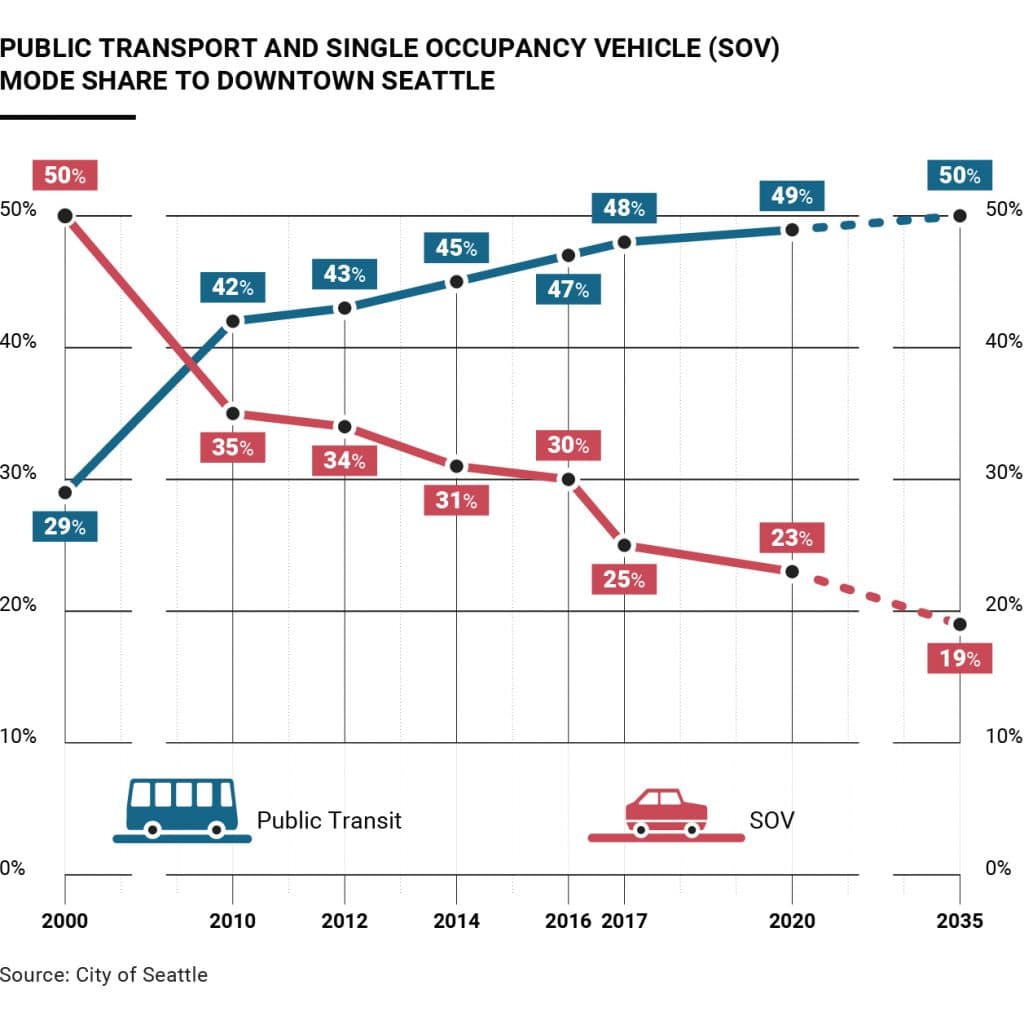
Expedia, Facebook, Google and, of course, Amazon. These are the big names driving Seattle’s construction boom, which has been rapidly and profoundly transforming the city’s urban fabric for the past ten years. Futuristic campuses, office skyscrapers, apartments for residential use: the city’s economy is vigorous, as demonstrated by the numbers released recently by the Downtown Seattle Association.
In 2019 there are 66 large real estate projects under construction in the city center, more or less the same number as in 2018, and slightly fewer than the 74 projects of 2017. For example, the Amazon headquarters alone is made up of 44 buildings, and the group already has permits to build for 32 new projects, plus another 129 on the list of future things to do.
From 2010, Seattle – which began as a port city – became America’s fastest growing large city in terms of population in 2017. Its economy is also doing well. Population has increased by 20%, and jobs by 19%. These numbers are reflected by today’s urban transformation.
When a city becomes a construction zone
In order to understand Seattle’s building boom, look no further than the fact that about half of the apartments in the city center have been built in the last ten years, according to the Downtown Seattle Association.
The record belongs to the Greater Downtown area where 5,700 new real estate units were built in 2017, 3,800 last year, 3,500 are currently under construction and 5,600 planned for 2020.
These are signs of a city in ferment, which also boosts tourism and therefore the hotel sector. In 2018 alone, 2,100 new hotel rooms came on stream, more than the number in the entire last decade. This was mainly due to the opening of the Hyatt Regency Seattle, the 1,260-room mega-hotel opened in the Denny Triangle. The Denny Triangle, along with Capitol Hill, are the two areas benefitting the most from the city’s real estate development frenzy. The average real estate prices have risen 85% from 2012, according to the municipal administration, transforming the city center into one of America’s most expensive places to live.

Tech multinationals drive growth
The city’s building boom is being driven by large high-tech multinationals. One step at a time, Seattle is becoming a magnet for some of America’s most important multinationals. One of them, Expedia, is spending $600 million on a new corporate campus, currently the city’s largest building project.
The economy is growing, the labor market is bubbly and businesses are looking to expand. In 2019, 420,000 square meters of new office space will open to host the “invasion” of white-collar workers as Facebook and Google expand their respective campuses.
These large groups, following the example given by Microsoft and the Bill & Melinda Gates Foundation, actively participate in the life of the city, making their contribution to foster sustainable mobility.
In February, the Alaska Way tunnel, one of the main arteries for entering the city, was closed for three weeks. To avoid congestion, the city administration asked residents to leave cars at home and use public transport. The big companies did the same, starting with Amazon, which increased the number of company shuttle rides that connect Colman Dock to South Lake Union serving the West Seattle area. The Bill & Melinda Gates Foundation, on the other hand, encouraged its employees to use the shared transport vehicles made available by the Foundation, while JP Morgan encouraged people to go to work in the neighborhood branches, thus reducing the movements to downtown headquarters.
Infrastructure to cope with the boom
This urban development, which is driven by the economic and demographic growth of the city, must necessarily be supported by an improvement in infrastructure endowment, especially in terms of sustainable mobility.
One of the most significant projects currently being looked at is the extension of the light metro from West Seattle to Ballard Link, a large-scale work that will cross the city connecting with other lines of city transport. According to the timeline published by Sound Transit (the regional transport authority operating in Puget Sound, in the state of Washington) the next few years will be devoted to defining the project, which will pass through a series of studies, including environmental impact. Actual construction will begin only in 2025 with opening scheduled for 2035.
In addition to the light metro expansion project, Sound Transit has invested in recent years in the modernization of sustainable mobility in Seattle, creating a series of projects that have all been approved by residents, such as Central Link, the light rail line that runs below Downtown Seattle to the city airport.
This increase in urban public transport has helped decongest the city center by convincing more and more people to leave their car at home. The Seattle Department of Transportation said in its “All Aboard” report that between June 2017 and June 2018 there was a daily increase of 9,900 light bus and underground users, + 2.8% for a total of 365,300 people. Another sign that the city is growing along with its transport system.

